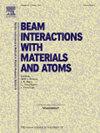Energy and profile of the proton beam of the IBA Cyclone 18/9
IF 1.4
3区 物理与天体物理
Q3 INSTRUMENTS & INSTRUMENTATION
Nuclear Instruments & Methods in Physics Research Section B-beam Interactions With Materials and Atoms
Pub Date : 2025-05-19
DOI:10.1016/j.nimb.2025.165710
引用次数: 0
Abstract
The characteristics of the proton beam produced by the IBA Cyclone 18/9 medical cyclotron were investigated, focusing on its energy and profile. The proton beam energy was measured as MeV using activation foil detectors. The beam profile was characterized using the Timepix3 based detector, revealing a Gaussian distribution with consistent widths and slight asymmetry in the horizontal plane. This study presents a straightforward methodology for evaluating cyclotron beam parameters using activation foils and pixel detectors, providing a tool for optimizing target design and expanding the applications of medical cyclotrons beyond radiopharmaceutical production.
IBA气旋18/9的质子束能量和剖面
研究了IBA旋风18/9医用回旋加速器产生的质子束的特性,重点研究了其能量和剖面。利用活化箔探测器测得质子束能量为18.25±0.25 MeV。利用基于Timepix3的探测器对光束轮廓进行了表征,显示出宽度一致的高斯分布,在水平面上有轻微的不对称。本研究提出了一种使用激活箔和像素探测器评估回旋加速器束参数的简单方法,为优化目标设计和扩大放射性药物生产以外的医疗回旋加速器应用提供了工具。
本文章由计算机程序翻译,如有差异,请以英文原文为准。
求助全文
约1分钟内获得全文
求助全文
来源期刊
CiteScore
2.80
自引率
7.70%
发文量
231
审稿时长
1.9 months
期刊介绍:
Section B of Nuclear Instruments and Methods in Physics Research covers all aspects of the interaction of energetic beams with atoms, molecules and aggregate forms of matter. This includes ion beam analysis and ion beam modification of materials as well as basic data of importance for these studies. Topics of general interest include: atomic collisions in solids, particle channelling, all aspects of collision cascades, the modification of materials by energetic beams, ion implantation, irradiation - induced changes in materials, the physics and chemistry of beam interactions and the analysis of materials by all forms of energetic radiation. Modification by ion, laser and electron beams for the study of electronic materials, metals, ceramics, insulators, polymers and other important and new materials systems are included. Related studies, such as the application of ion beam analysis to biological, archaeological and geological samples as well as applications to solve problems in planetary science are also welcome. Energetic beams of interest include atomic and molecular ions, neutrons, positrons and muons, plasmas directed at surfaces, electron and photon beams, including laser treated surfaces and studies of solids by photon radiation from rotating anodes, synchrotrons, etc. In addition, the interaction between various forms of radiation and radiation-induced deposition processes are relevant.

 求助内容:
求助内容: 应助结果提醒方式:
应助结果提醒方式:


